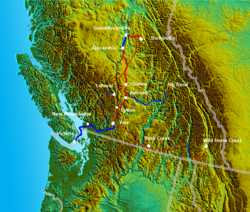Route Cariboo
- Route Cariboo
-

Tracé de la route Cariboo (en rouge sur la carte).

Tronçon de la route Cariboo près de Yale (1867-1868).
La route Cariboo (Cariboo Road) était un projet de construction de route initié en 1860 par le gouverneur de Colombie-Britannique James Douglas. La route devait relier les localités de Yale et de Barkerville en passant par une zone dangereuse composée de canyons.
Le projet de route devait permettre de rejoindre plus facilement la région Cariboo où de l'or était exploité suite à une ruée vers l'or. Le seul accès à cette zone se composait d'un sentier le long d'une falaise où une seule mule pouvait passer à la fois.
La construction de la route eut un coût de 1,25 million de dollars alors qu'elle fit transporter l'équivalent de 6,5 millions de dollars en or. A l'origine, la route aurait dû se prolonger jusqu'en Alberta mais cette partie du projet fut abandonnée.
Voir aussi
Lien interne
Biographie
Wikimedia Foundation.
2010.
Contenu soumis à la licence CC-BY-SA. Source : Article Route Cariboo de Wikipédia en français (auteurs)
Regardez d'autres dictionnaires:
Route de l'alaska — En rouge, la route de l Alaska. La route de l Alaska (Alaska Highway, communément appelée Al can), est une route stratégique qui relie Dawson Creek, en Colombie Britannique, à Fairbanks, en Alaska, via Whitehorse, au Yukon. Ell … Wikipédia en Français
Cariboo Road — The Cariboo Road (also called the Cariboo Wagon Road, the Great North Road or the Queen s Highway) was a project initiated in 1862 by the colonial Governor of British Columbia, James Douglas. It was a feat of engineering stretching from Fort Yale … Wikipedia
Cariboo Gold Rush — The Cariboo Gold Rush was a gold rush in the Canadian province British Columbia. Although the first gold discovery was made in 1859 at Horsefly Creek by Peter Dunlevy, followed by more strikes at Keithley Creek and Antler Horns lake in 1860, the… … Wikipedia
Cariboo-Goldrausch — Barkerville (1865) Der Cariboo Goldrausch ist eines in einer Kette von Ereignissen, die zwischen etwa 1858 und 1900 mehrere hunderttausend Menschen in den Westen Kanadas brachten. Diese Kette setzte 1858 mit dem Fraser Canyon Goldrausch ein und… … Deutsch Wikipedia
Cariboo camels — The saga of the Cariboo camels is one of the most interesting pages in the history of British Columbia. The Bactrian camels were used on the Douglas Road and the Old Cariboo Road in 1862 and 1863 to haul freight during the Cariboo Gold Rush.… … Wikipedia
Cariboo — The Cariboo is an intermontane region of British Columbia along a plateau stretching from the Fraser Canyon to the Cariboo Mountains. The name is a reference to the woodland caribou that were once abundant in the region. The Cariboo was the first … Wikipedia
Route de l'Alaska — En rouge, la route de l Alaska. La route de l Alaska (Alaska Highway, communément appelée Al can), est une route stratégique qui relie Dawson Creek, en Colombie Britannique, à Fairbanks, en Alaska, via Whitehorse, au Yukon. Elle est longue de… … Wikipédia en Français
Grande route de l'Alaska — Route de l Alaska En rouge, la route de l Alaska. La route de l Alaska (Alaska Highway, communément appelée Al can), est une route stratégique qui relie Dawson Creek, en Colombie Britannique, à Fairbanks, en Alaska, via Whitehorse, au Yukon. Ell … Wikipédia en Français
Old Cariboo Road — The Old Cariboo Road is a reference to the original wagon road to the Cariboo gold fields in what is now the Canadian province of British Columbia. It should not be confused with the Cariboo Road, which was built slightly later and used a… … Wikipedia
Vessels of the Lakes Route — also called the Lillooet Trail), the route consisted of a series of wagon roads connected via lake travel in between. A variety of craft were use on the lakes, from steamboats to sail driven rafts to, through the early 20th Century, diesel and… … Wikipedia


